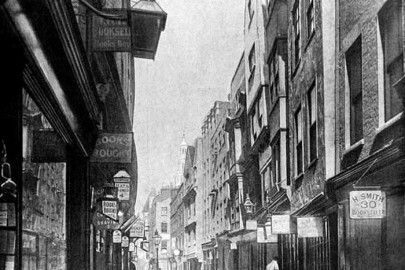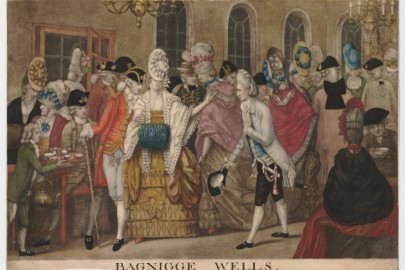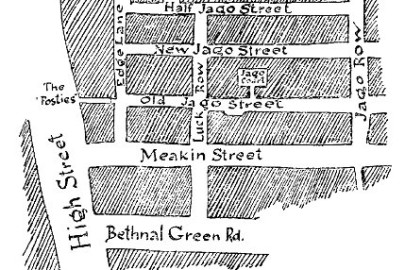Jonathon enjoys a new ‘tour d’whorison’ by a blogger of historical bawdiness…
Emily Brand (or Ms B—d as she signs in that manner created by the immortal Tom Brown see Heroes of Slang) is a young historian who writes the blog The Georgian Bawdyhouse, a thesaurus of choice information subtitled ‘an Exploration of Crime, Disorder & Lewdness in the Long Eighteenth Century.’ Among its recent revelations are a bawdy song for a wedding night (‘Not be nice [i.e. pernickerty] in yielding / But loving and willing’), a cure for a nagging wife (‘For this you must take a Gallon of Geneva, or otherwise called wilful murder, give it to her in a morning, and if that won’t do give her two’), and a fictional love letter from a jack tar of 1799 (‘I hope Sall, during my absence, you did not suffer any of the enemies to fall foul of your quarter deck, and that I shall find my frigate tight and in good condition, lying in ordinary, and unmanned’).
She has written a history of royal weddings, publishes pieces on domestic and family life in a variety of outlets and has now turned the blog into a book, well, a 56-page pamphlet, entitled The Georgian Bawdyhouse (Shire Library £6.99). Unlike the blog, however, it focuses on a single topic: prostitution in the 18th century. It is wonderfully illustrated – Gillray, Hogarth, Cruikshanks of sundry initials, Rowlandson and many more. It is not to belittle the author’s text, which, while miniaturised, takes in every aspect of the period’s commercial exploitation of female flesh, to say that the pictures are half the delight. Gelded by political correctness, we lack the unfettered appetites and honesty of our predecessors. Irrespective of her social position, and any moral assessment of her occupation, a whore was a whore and let us – kindly, cruelly, satirically, coarsely – note the fact. The exposure of breasts suggests that the Duchess of Cambridge would have found less sympathy (or is it hypocrisy) among the contemporary media.
The index covers but a page but takes in adultery to virginity, alcohol to tea-drinking and Jane Austen (yes, that Jane Austen joking as to the possibility of her being lured into prostitution – as were so many young women – upon her first trip to London) to the courtesan Harriette Wilson. All of which topics (all right, perhaps not Miss Austen), as Dabblers will know, run close to Mr Slang’s leprous, encalcined heart. It was a seemingly permissive age, and commercial sex gave another angle on the changes being wrought by the Enlightenment. Blake might bemoan the harlot’s cry, but she (and for those who preferred mollies, he) was still available from street to street not to mention house to house. Grandes horizontales such as the rampageous Sally Salisbury, the beautiful Emma Hamilton and the devil-may-care Kitty Fisher (who once ate a 1,000 guinea banknote on a slice of bread to show her scorn for cash) could move from gutter to grandeur and back again. Bawds, invariably garlanded with the ironic honorific ‘Mother’, included Elizabeth Needham, Catherine Windsor, Elisabeth Cresswell and Moll King (in whose coffee house in Covent Garden it is said that the flash language – the era’s variation on criminal cant – had been launched). Brothel-keeping was technically illegal – the law was rarely enforced, and the abbess (possessed of a nunnery and its nuns) could do well: ‘Mother’ Hayward, who died in 1743, was worth £10,000 – a million in today’s purchasing power.
Of the slang’s 263 references to brothel 65 are of 18th century vintage (and the century offers 200 other terms from prostitution). House is the key word: leaping house, and vaulting house, nugging house and punch house, and the various houses of civil reception or civil entertainment, of call, of conveniency, of delight, of pleasure, of profession, of resort, of sale and of state. Just next door were the the synonyms: ken (the smuggling – i.e. hugging and kissing – ken, snoozing ken and wapping – i.e. fucking – ken); shop (buttocking shop and gig shop – a gig being a flighty young woman), and school (dancing school, pushing school, fencing school and school of Venus). There were also the free-and-easy and the flash drum, house, ken or panney.
No prostitute could exist without the client, ‘the man of pleasure’. The run of the mill culls have naturally vanished; as traceless as the names of their unsung, cheaply purchased partners, but some grandees are remembered and Ms Brand offers such as ‘Old Q’ (the Fourth Duke of Queensbury), Col. Francis Charteris (known as ‘the Rape-master General of Great Britain’) and James Boswell, who seems always to have had time for diversions other than the cataloguing of Samuel Johnson’s bons mots. There are pictures of these leering lechers too, usually – lest we overlook their obsession– with a hand placed deep in a trouser pocket.
It was not all slap and tickle. Despite sheep’s gut condoms there was always a chance of the pox (Ned Ward’s catalogue of clubs includes The No Nos’d: those whose features had been eroded by syphilis), and for the girls, who might not have been legally guilty of anything, but could still be arrested for ‘disorderly behaviour’, the public whipping, the pillory (which could be fatal) and the prison. There were also the moralists, ceaselessly if only partially effectively campaigning against ‘Satan’s regiments’. These might be found in organisations such as the Society for the Reformation of Manners, but they might also appear more spontaneously as bands of drunken sailors, smashing the brothel’s furniture and beating the whores.
Nothing lasts. Whoring might be the oldest profession and Victorian London had more than its fair share of both street girls and brothels, but the attitudes did alter. The hand-wringing, vengeful forces of Evangelical Christianity pushed their own fears and superstitions into the foreground and turned the whore into a ‘social menace’. As Ms Brand concludes her excellent tour d’whorison, the moralisers ‘strapped the formerly heaving bosom into a strait-laced Victorian corset and banished the open business of pleasure firmly to the past.’ Ours too is a supposedly permissive and certainly hyper-sexualised age, but whore and her world have yet to cast their tight-laced clouts.













If the book/pamphlet is half as good as the review, I’ll buy a copy. I wonder if Boswell used a sheep’s gut condom? His reputation suggests he might have had the sheep as well as use of its innards. Well, what else could a virile young chap do whilst travelling the Western Isles with old SJ? What a lad he was:
‘I then called at Louisa’s and begged to be allowed what I most desired. She would not consent today as everybody was at home.’ Bloody hell: fifteen downstairs, ten upstairs, five in the potting shed, and he was still up for it……..
Those poor girls; how they suffered. I had never thought of some of them dying in the pillory, until today. But I suppose the health of many of them was so fragile that they were simply unable to tolerate the rigours of being clamped within the device, nothwithstanding the obnoxious rubbish thrown at them.
That’s another blog added to the RSS feed!
When I lived in Erin many years ago condoms were banned, but the Irish are a resourceful race and, particularly in rural areas (which means just about everywhere), the most popular substitutes were Mars Bar wrappers with one end torn-off, or the cling-film that your wife/girlfriend/mother used to wrap your sandwiches. And if you have the energy to pop back a thousand years to the 10th Century’s King of Kings Brian Boru, you will discover that the old horndog used elk-hide. The last two lines of the ballad that features the old roue, I just happen to have beside me, and they prove beyond doubt that consideration for your partner’s pleasure did not spring up in my lifetime…
“Well, you’ve had yer own way long enough, dear…
Tis the hairy side outside, tonight”.
What a sweetheart he must have been, no?
Brilliant MM! Although somewhat eye-watering
As ever, wonderful stuff, JG. I wonder whether prostitution is a constant in society or whether its incidence rises and falls, along with social mores. In today’s central London it seems to have disappeared from most of its traditional haunts – but has it merely been displaced? There’s probably a grant in it for some enterprising sociology research student.
I suppose ’tis all on the internet these days G
But where’s the physical location that the nugging occurs? All over the place I suppose?
All over the place, but invariably up-close and personal. Nug is from dialect where it meant to jog with the elbow (locus classicus being M. Python’s nudge-nudge wink-wink sketch).
Robert Copland, later the first person to collect cant, offered this in 1505 in his Complaynte of Them that ben To Late Maryed:
My wyfe shewed to me her proper dugge,
On the mornynge her delyte for to make,
And to haue me for to play nugge a nugge.
Workers in the nugging house wore a nugging-dress, a loose dress which indicates a courtesan (and a descendant of the similarly metonymic ‘loose-bodied gown’).